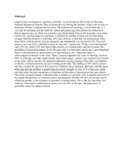| dc.description.abstract | Laparoscopic investigation of primary infertility was performed in 104 women at Kenyatta National Hospital in Nairobi. Time of admission was during the 2nd half of the cycle in order to determine whether ovulation had occurred. The endometrial curettings were divided into 2: 1 was sent for histology and the other for culture and guinea pig innoculation for tuberculosis. Before laparoscopy, an effort was made to study the husband. Criteria for normality were either satisfactory seminal analysis or presence of children by another woman, the last born being younger than the duration of infertility. 24% had a history of disorders of menstruation. Only about 66% of the husbands were investigated, and abnormality was detected in 5%. The total patency rate was 22.6% with half of these having only 1 patent tube. Of the cases with blocked tubes (73.1%), nearly 25% had tuboovarian masses as a complication, and this excludes the possibility of surgical treatment. In the 26 cases with 1 or both tubes patent, the 2 most important factors were disorders of menstruation and anovulation on the 1 hand and faulty or uninvestigated husbands on the other. These 2 factors explained the cause of infertility in about 50%. In selecting cases that might benefit from tubal surgery, criteria were minimal involvement of the tubes with no masses, few peritubal adhesions causing kinking of the tubes, and fimbrial occlusion as demonstrated by the dye swelling up the tube. The finding of 76% tubal occlusion rate far exceeded the figure of 56% given by Chatfield, Suter, Bremner, Edwards, and McAdam, indicating that the problem is greater than previously thought. In only 25% of the cases could one help either through reassurance or treatment of disorders of menstruation and anovulation. The scope of surgical repair of blocked tubes is limited to a possible 12%. It appears necessary to reconsider the priorities at overtaxed clinics and hospitals. Possibly the best service that can be offered to patients is the treatment of disorders of menstruation. Due to the fact that there was evidence of past pelvic inflammatory disease in over 80% of all cases, the importance of gonorrhea cannot be underestimated. | en |

